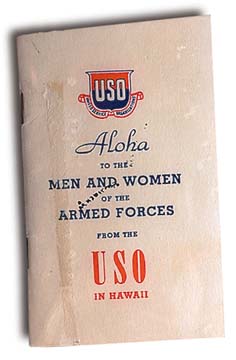


Boosting morale
By Blase Camacho Souza
is a cheerful task
on home front
Special to the Star-BulletinScrubbed and starched, they came into Waialua on Tuesday nights -- off-duty soldiers who arrived by truck and weapons carrier from Kahuku, Pupukea, Kawailoa, Puuiki Woods and Haleiwa.
As one of them put it, "Those with two left feet went to the movies, the rest of us went to the Waialua Gym to dance, to enjoy the music, to talk to a girl."
World War II brought thousands of soldiers into Waialua and other North Shore spots, prompting the Waialua Community Association to do its share in the "war effort." One most successful project, co-sponsored with the USO, were dances for the enlisted men.
The association was directed by Gordon Virgo; the USO was represented by program director Jerry Upson, who contacted the military, made arrangements for orchestras, and coordinated the activities.
Women who represented the "upper crust" of social life in this plantation community were the unofficial hostesses and chaperones. They drove the local girls to and from the gym, and also danced and talked with the GIs.
For the young women, it was a chance to make a difference in the war -- to dance with someone who was there that night, but next week may be sent to a South Pacific island, to battle and never return.
As Helen Sandersan, a Kansas native who taught kindergarten at Waialua Elementary School, put it: "I would be so tired, but Jerry Upson dragged us to the gym and soon I was invigorated by the dancing and talking to the guys." The teachers at the school, both Hawaii-born and mainland-born who worked in Waialua, were independent and freely chose to attend these affairs. Other "local" girls, Chinese, Filipino, Hawaiian, Portuguese and others, all went to enjoy an evening out.
The Japanese girls, however, felt a special obligation to attend the dances. Their parents felt the need to have their daughters make a contribution to America's war efforts, as had their sons and brothers by enlisting voluntarily in the United States armed forces.
All the girls dressed in their best formal outfits and wore heels and silk stockings. And, as Violet accurately described it: "The girls were picked up and delivered safely home. There was no chance for hanky-panky, and there was no stigma attached to participating in this social event."
Everyone hoped for a good orchestra and they were not disappointed. One of the favorites was the 7th Infantry Division band; another was the Nautical Hawaiians, a navy orchestra led by Dick Dias (Dick Akamahou). Yet another was a Puerto Rican orchestra that added some spice by playing tangos and merengues in addition to the usual fox trots, waltzes, the jitterbug -- and the very popular swing.
There were tag dances: When the orchestra stopped, the men had to relinquish their partners and leave the floor. Fellows on the sidelines would then dash up to get a partner and have a chance to dance for a short while. There were some good spirits when several guys made a beeline for an especially popular girl who was a good dancer.
Some good, lasting friendships resulted from these dances. On her first day back in Kansas City, Helen bumped into Roy, with whom she had danced in Waialua. John Malone ran into a former dance partner in Macy's in New York City. Many years later, Violet met a former GI who had brought his family to see the Liliuokalani Church and the gym where he had danced in Waialua.
Pleasant memories and friendships flourished among the GIs and the girls, yes. But there were also sad occasions when news filtered back from the front that one of the fellows had been killed.
Still, the impressions, the moments and the memories were usually happy ones. Those at the dances could share good music, dance to it and have pleasant conversations with people who, as Johnny said, "were the nicest bunch of people I have ever met."